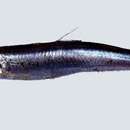Diagnostic Description
(
Inglês
)
fornecido por FAO species catalogs
Differs very little from the European anchovy (see Engraulis encrasicolus ) and can be identified from that description. Of other anchovies found in the southern part of its distribution, only species of Encrasicholina and Stolephorus are similar in appearance (slender, rather round-bodied), but all have small spine like scutes before the pelvic fins (usually 2 to 7 scutes, but occasionally 1 or very rarely none in S. commersonii ). Species of Thryssa have compressed bodies and a keel of scutes along the belly.
- Hayashi, (1967 - synopsis of biology and fishery)
- Jiang & Zheng, (1984 - eggs and larvae)
- Shen, (1969, 1971feeding, general biology)
- Uchida, et al. (1958 - good illustration of eggs and larvae)
- citação bibliográfica
- FAO Species catalogue Vol. 7. Clupeoid fishes of the world. (Suborder CLUPEOIDEI) An annotated and illustrated catalogue of the herrings, sardines, pilchards, sprats, anchovies and wolf-herrings. Part 2. Engraulididae.Whitehead, P.J.P., 1985 FAO Fish. Synop., (125) Vol.7 Pt. 2:305-579.
- autor
- Food and Agriculture Organization of the UN
Distribution
(
Inglês
)
fornecido por FAO species catalogs
Western North and central Pacific (southern Sakhalin Island, Sea of Japan and Pacific coasts of Japan, and south to almost Canton/Taiwan Island; rare records off Philippine coasts (Luzon, western Mindanao) and from - Manado and Ujung Pandang, Sulawesi, Indonesia).
- citação bibliográfica
- FAO Species catalogue Vol. 7. Clupeoid fishes of the world. (Suborder CLUPEOIDEI) An annotated and illustrated catalogue of the herrings, sardines, pilchards, sprats, anchovies and wolf-herrings. Part 2. Engraulididae.Whitehead, P.J.P., 1985 FAO Fish. Synop., (125) Vol.7 Pt. 2:305-579.
- autor
- Food and Agriculture Organization of the UN
Size
(
Inglês
)
fornecido por FAO species catalogs
To about 16 cm standard length, usually about 12 to 14 cm.
- citação bibliográfica
- FAO Species catalogue Vol. 7. Clupeoid fishes of the world. (Suborder CLUPEOIDEI) An annotated and illustrated catalogue of the herrings, sardines, pilchards, sprats, anchovies and wolf-herrings. Part 2. Engraulididae.Whitehead, P.J.P., 1985 FAO Fish. Synop., (125) Vol.7 Pt. 2:305-579.
- autor
- Food and Agriculture Organization of the UN
Brief Summary
(
Inglês
)
fornecido por FAO species catalogs
Marine, pelagicand near the surface, mainly coastal, but to over 1 000 km from the shore,forming large schools, tending to move more northward and inshore (into bays and inlets) in spring and summer, but without well-defined migrations.Feeds on copepods (the post-larvae chiefly taking the eggs and nauplii), but also on other small crustaceans, and molluscan larvae, as well as fish eggs and larvae; the data given by Shen (1969:tab.3) suggest that diatoms form an important food item in juveniles and adults, as might be expected by analogy with E. capensis . Spawns throughout the year, with peaks in winter and early spring in southern parts of Japan, and in spring and in autumn in the Pacific waters of central Japan and off northern Taiwan Island, mainly in the second year of life; eggs ellipsoidal, hatching in about 30 hours at 20 to 25° C, or 48 hours at 18° C.
- citação bibliográfica
- FAO Species catalogue Vol. 7. Clupeoid fishes of the world. (Suborder CLUPEOIDEI) An annotated and illustrated catalogue of the herrings, sardines, pilchards, sprats, anchovies and wolf-herrings. Part 2. Engraulididae.Whitehead, P.J.P., 1985 FAO Fish. Synop., (125) Vol.7 Pt. 2:305-579.
- autor
- Food and Agriculture Organization of the UN
Benefits
(
Inglês
)
fornecido por FAO species catalogs
Fished commercially in Japan since the 10th century; abundant catches from about 1890 to 1912, fluctuating to 1930, a decline, followed by an increase and further fluctuations, usually inversely correlated with fluctuations in the catch of sardines (Sardinops melanostictus ). Not only adults, but post-larval stages (sirasu in Japan) exploited. Mostly caught by two-boat purse seines (60%) and boat seines, in autumn in northern parts of Japan, in spring and autumn in the Sea of Japan. The total catch reported for this species to FAO for 1999 was 1 820 259 t. The countries with the largest catches were China (1 096 916 t) and Japan (484 230 t).
- citação bibliográfica
- FAO Species catalogue Vol. 7. Clupeoid fishes of the world. (Suborder CLUPEOIDEI) An annotated and illustrated catalogue of the herrings, sardines, pilchards, sprats, anchovies and wolf-herrings. Part 2. Engraulididae.Whitehead, P.J.P., 1985 FAO Fish. Synop., (125) Vol.7 Pt. 2:305-579.
- autor
- Food and Agriculture Organization of the UN

